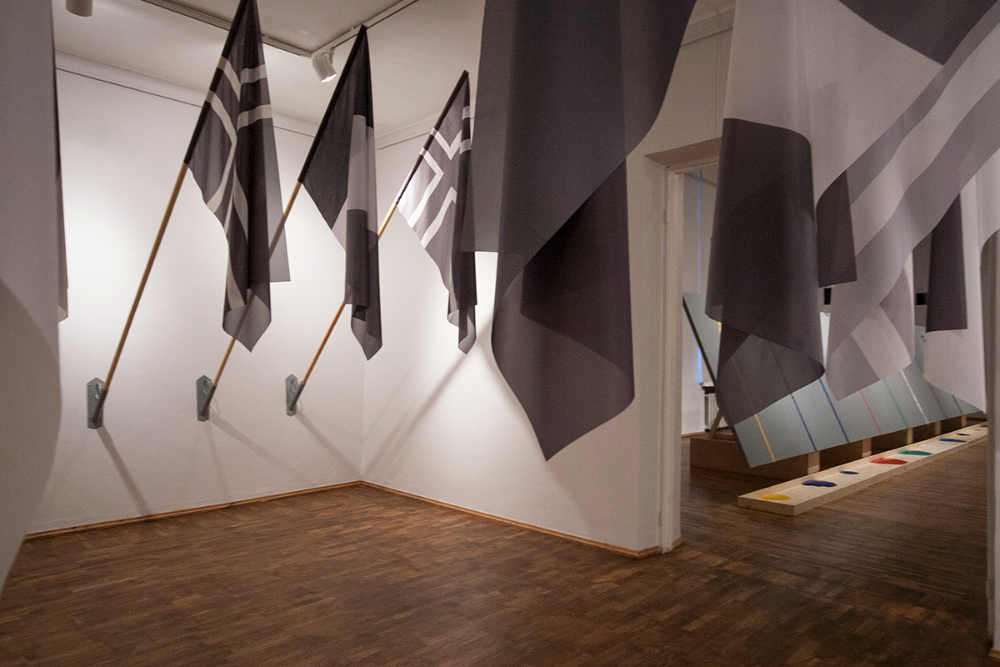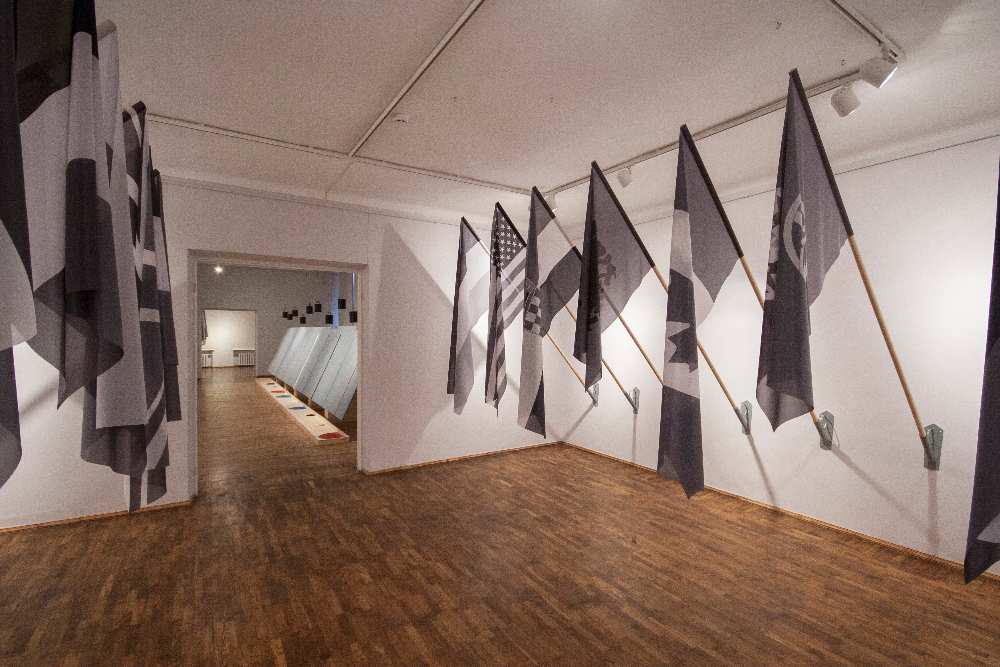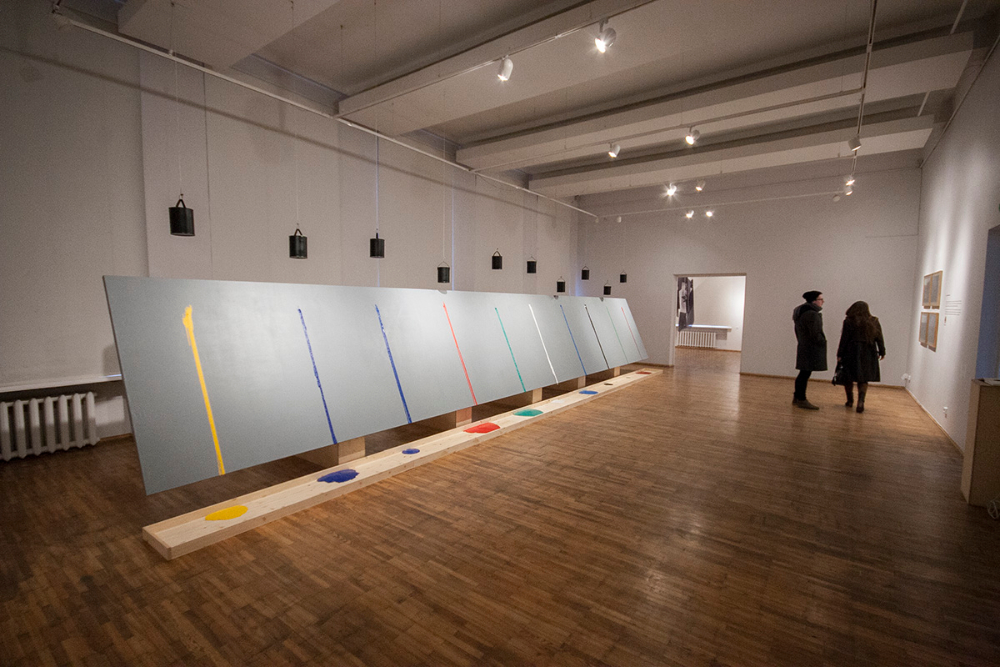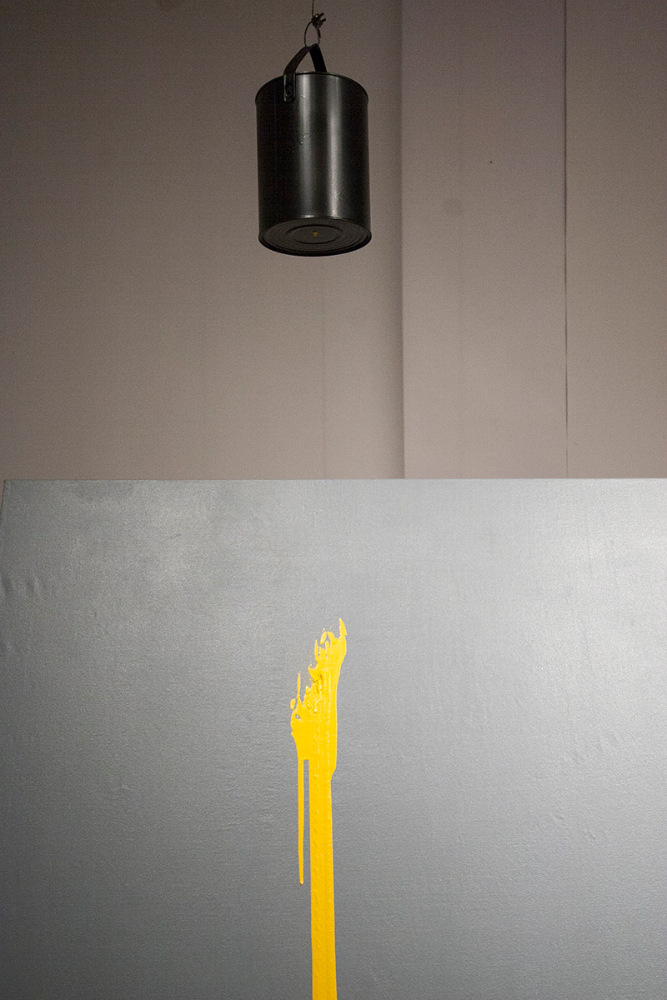
Maarit Murka’s exhibition “Contact” in Tartu Art House consists of, to put it simply, black-and-white flags of NATO member countries, gray canvas stretched through the Big Gallery of Tartu Art House and a number of hanging pots from which different colours drip down the gray canvas.
In social media, particularly the comments’ section, a work by Wilfredo Prieto, an artist of Cuban origin, called “Apolitico” (2003) that consists of colourless flags of thirty-three countries has been referred to in relation to Murka’s “Contact”. Though this parallel hasn’t directly been brought out anywhere, we can assume that they are first and foremost referring to the similarities of these two pieces, which certainly cannot be denied. Actually, the contents are similar as well. The aim of Prieto’s installation – as the title “Apolitico” says – was to unpoliticize the flags, to turn opponents into companions. Murka’s installation “Context” wants to highlight leaking dissensions from the unanimous system of unvaryingly gray NATO. Thus, according to the author’s text, the word “contact” means coming vis-à-vis with an enemy in militaristic jargon. Despite having opposite positions, both artists use flag colours as a symbol of different political aims.
This parallel is indisputable, though it does not offer anything in the context of these two artists besides rendering meaning to two certain works. When widening the circle of authors, the subject of analysis could be the use of flag colours in politically engaged art projects; but this is not the aim of this article. This is because the form of Murka’s installation “Contact” is strongly connected to her established poetics.
Known as a painter who only uses black and white, Murka uses colours to highlight symbolic, invisible stratum of content. This is manifested most conspicuously as red lipstick marks in her series called “Marked” (2011-2012). Or in a more political way as golden buttons in a self-portrait “The First Painting after My Grandmother Died at 29.09.2007” (2007), which is a part of the series “Hitler. Thing or Faith?”. In that series, the symbolic value of colour is highlighted with the fact that Hitler’s notorious moustache that is a recurring motif in the portraits is black. The question’s ambivalence is clearly understandable. Are the moustaches here just some thing, black-and-white like everything else on the painting, or are they a political symbol that lacks colour just because of historical ineluctability?
The equivocalness of working with colours and greyscale is pointed out also in the paintings “White House/Black House” (2009) or glass mosaic “Red Soldier” (2002). However, the subject of colours in Murka’s creation is too voluminous to stay on it in this article (even if we were to discuss only the analysis of colour as a political, personal, and compositional tool). Thus let’s content ourselves with concluding that the colours in “Contact” are first and foremost symbols of political positions, and that Murka has used them before in similar way and function.
Murka has used flags, the other important figure of “Contact”, before in her painting series “I’m an Artist from Post-Soviet Country” (2008), and as a follow-up of the same theme in her painting “True Estonian” (2010). In the latter, there are erect figures wrapped in Estonian and Russian flags that were depicted in different paintings in the series but now are “pasted” together in a collage-like manner, depicting a piece from one painting next to a piece from the other. This technique is very Murka-ish: juxtaposing horizontal cut-outs, and in that, one could see a key to the layout of the installation “Contact” – a line of black-and-white flags with vertical streams of colour. Though, this only confirms that it is to do with a style very like Murka, and does not offer a possible interpretation.
The most direct parallels can be found with the installation “Dark Land” (2010) exhibited in Hobusepea Gallery in Tallinn. In the centre of the exhibition was an actual national project “Bringing Talents Home”. Murka named five reasons why people leave their home country: self-realization, climate, experience, egoism, and envy. These five reasons were written in red on the Plexiglas covering the portraits. What was noteworthy about the installation was that the maps that covered the gallery’s second floor walls were black. Murka commented on the choice herself in an interview given to Elin Kard: “A talent’s home shouldn’t be tied to one continent or country. A talent should be cosmopolitan. A talent should live wherever she feels best and most comfortable.” Murka does not name politics as one of the reasons to leave one’s home country, and instead of the highlighting the politics of destination countries, she rather points out how personal they are by painting her own preferred destination countries (?) black but depicting a pair of eyes on them.
The personal aspect, the clearest centre of Murka’s creation as shown by her innumerable self-portraits, seems to be missing from the installation “Contact”. Still, based on her previous work, the mere politicality of the installation seems to be deceptive. “Contact”, which is based on the artist’s experience in visiting a mission in Afghanistan – where she was a civilian, and an individual also in the sense of not belonging to a hierarchical collective environment – is not a symbol of only differences between NATO member countries but also of the artist’s personal rebellion against militaristic discipline she suddenly came into contact with.



©Tartu Kunstimaja






























